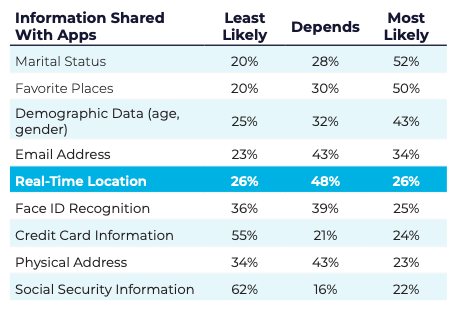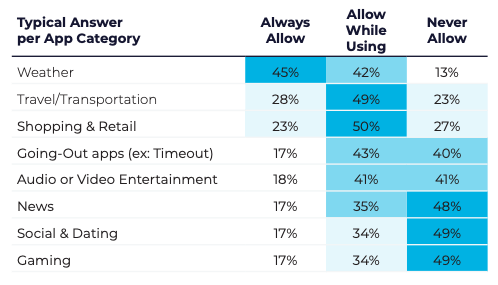Marketers should be able to get more than 60% location opt-ins if they follow best practices
Control and value are key to convincing the “it depends” crowd to share their data.
As CCPA, ITP and the forthcoming cookiepocalypse threaten the availability of third-party data for targeting and attribution, mobile-location tracking has emerged as a potential cookie alternative. But mobile operating system privacy controls and iPhone location alerts are starting to impact the availability of high-quality location data.
Location is also key tool for personalization. But in this new more privacy sensitive environment, getting consumers to share “always-on” background location or even opt-in to location sharing during app use have become bigger challenges for publishers and marketers.
Consumers are ambivalent about location-data sharing. While the evidence shows the public has historically been ambivalent about location sharing, new survey data reflect increasing sophistication and sensitivity about context and use cases.
The first survey of more than 1,300 U.S. adults, conducted by contextual marketing platform Herow, found that the public was roughly equally divided into thirds. One third always accept app location requests, another third always deny them and the final third says “it depends.”
I also recently conducted a Google consumer survey of 750 U.S. adults and found something directionally similar but slightly different. The question was: “Your smartphone always knows where you are in the world. Does that worry you?”
On a 10-point rating scale, people were asked to identify their level of concern from “not at all concerned” to “extremely concerned.” Accordingly, 16% of the audience was “not at all concerned” about location tracking, 18% was “extremely concerned,” and the rest fell somewhere in between. However the largest single group “in the middle” was precisely in the middle, reflecting uncertainty, ambivalence or “it depends.”
Millennials most open to location sharing. In the Herow survey, Millennials were the most likely to share their location (44%) compared with other generations. Gen Z was next with 40%. My survey found that Gen Z was the demographic group most likely to say they were “extremely concerned” (23%), while Millennials were the most likely to say “not at all concerned” (19%).
How sensitive is location vs. other personal data?

When and why users share location. In the hierarchy of personal data, real-time location fell exactly in the middle according to the Herow survey. When asked about specific apps and contexts, as the chart below indicates, users are more likely to share location when there’s a clear relationship between the app’s purpose and user location, travel (high) vs. gaming (low), for example.
What apps will users share location with?

Control and perceived value are key. The Herow survey offers something of a guide for publishers and marketers in terms of gaining user trust and access to location. Users were more likely to share location if the app:
- Provides a clear and easy way to control if and how user data is used — 74%
- Explains clearly why it is asking for location and what is the value for the user — 70%
- Provides a method to select when and for how long the location is accessible by the app — 65%
- Has an established brand — 59%
- Is a brand that users are attached to — 59%
- Complies with a major privacy regulation such as GDPR in Europe or CCPA in the United States — 53%
Overall, if the app gives users a feeling of control and improves the app experience or they understand that location is being exchanged for valuable content or services, they’re more inclined to share their data. They’re least inclined to share if they perceive the request to be an invasion of privacy or surveillance or there’s a risk of the misuse of their data.
Why we care. Herow says that mobile apps “should aim to reach a 66% location opt-in rate.” Half of that segment will be “more or less assured,” while the other 33% — the “it depends” crowd – will need to be convinced.
The key to convincing them to share location is communicating the value of doing so and providing reassurances that their data aren’t going to be misused or abused. Giving users a basic sense of control over their data is also critical in winning their trust and confidence.
(12)


